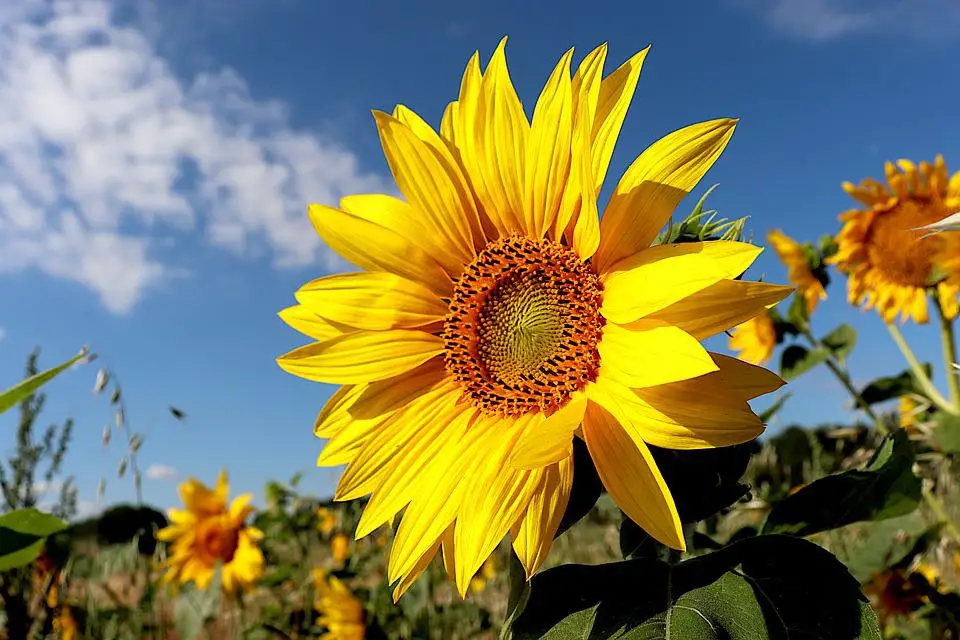As Poslovni Dnevnik writes, due to the ongoing war in Ukraine following Russian invasion back in February this year, there was a huge disturbance and uncertainty and shortages in supply, as well as a drastic rise in prices on the global market of sunflowers, sunflower products and particularly sunflower oil. Production of these products in Ukraine and Russia were of course deeply affected, and their exports otherwise dominate the global market. Is this a chance for the humble Croatian sunflower?
The most significant disturbances on the global market in the next period will be in the supply and demand of sunflower products such as the heavily used oil, due to the high concentration of production and the usual exporting of sunflower oil from both Ukraine and Russia. Any further prediction of price movements and supply in the market will primarily depend on the ability to supply sunflower oil and grain from Ukraine this season, but also the course of the war and the logistical conditions for the delivery of supplies to the rest of Europe.
“Croatian sunflower production has been growing over more recent years, in terms of production, although the area on which sunflowers are planted and cultivated hasn’t increased. Croatia produces more sunflowers than it needs. Self-sufficiency stands at about 212 percent, but we meet only 44 percent of the need for sunflower oil. Given that we have production capacities for processing sunflower products into sunflower oil, it would be logical, given the rising prices, to provide larger quantities of Croatian sunflower oil and to process domestic sunflower grain in factories here in Croatia. This would ensure a stable supply of oil for the domestic market, and we have the capacity to export this highly sought after and now expensive product, which is in great demand in the global and EU markets,” concluded the market analysis of experts from Smarter, a consulting company specialising in agriculture and food industry.
Sunflower oil production in Ukraine back in 2020 amounted to 6.45 million metric tonnes (MT), in Russia, 4.45 million MT, and in the EU 3.9 million MT. These are the three most important production areas in the entire world, while all the others are much smaller producers. The Ukrainian sunflower oil industry is focused on the export market because as much as 90 percent of production is intended for foreign markets, according to USDA data. Compared to Russia, which is the second largest producer, they consume almost 30 percent of their own sunflower oil production on their own market.
“In total, ports in the Black Sea account for almost 80 percent of the world’s sunflower oil exports, and today these areas are war zones. Given the strong dominance of Ukraine and Russia on the global sunflower oil market, Russia’s attack on Ukraine has caused an enormous impact on the global sunflower market, which is why it’s important to change the strategic thinking about the production of Croatian sunflower oil,” Smarter experts noted.
Russia’s horrific invasion of Ukraine has significantly disrupted that large Eastern European nation’s sunflower oil industry and supply chain, while an extension of the conflict threatens the next growing season. Plants which process sunflower seeds into oil have largely ceased operations, and the closure of ports prevents exports. Sunflowers are sown in Ukraine in April and May, and the harvest usually begins in September. There is a huge risk now when it comes to supply and demand because military actions are taking place in agricultural areas – many roads are blocked, commercial companies aren’t working, farmers can’t plant, and it’s very difficult to get raw materials for quality sowing (fertiliser, fuel, protective equipment, and the like).
The main areas of sunflower seed cultivation in Ukraine are located in the steppe and forest-steppe zones of the country, located in the central and eastern provinces. The main production regions are Dnepropetrovsk, Kirovograd, Kharkov, Zaporozhye, Nikolaev, Lugansk, Odessa and Poltava, which together make up 62 percent of the total sown area in the country. Due to the export market orientation, most of the Ukrainian plants for sunflower processing and production of sunflower oil are located near the Black Sea ports for logistical convenience. It’s now evident that the most important production basins and the possibility of delivery are endangered by the ongoing war.
In addition, Russia has announced restrictions on sunflower oil exports and a ban on the supply of sunflower seeds to ease pressure on Russian prices. All this causes great nervousness and fear for global supply and demand, and the price and availability of sunflower oil.
Could Croatian sunflower products and oil find a silver lining and find a new position for itself?
The lack of sunflower oil on markets around the world is trying to be compensated for based on available stocks, and new routes of supply from South America or South Africa. But this will not be enough to make up for the quantities which would usually be coming from the markets of Ukraine and Russia. EU oilseed processors are also increasing their sunflower oil production, in part by using sunflower seed imports from South America.
“In the EU, the processing of sunflower into sunflower oil is growing rapidly and strongly, more than expected. It’s estimated to reach 9.3 to 9.4 million tonnes by the end of this processing season (July 2022), compared to 8 million tonnes in the previous season. The largest increases in production are being recorded in Romania, Bulgaria, France, Hungary and Spain with very favourable profit margins. We’re also looking for substitutes for sunflower oil in other types of oil, especially palm oil, but also soybean oil, rapeseed oil, olive oil and other types of fats that can replace sunflower oil,” said the group of Smarter experts.
The return to the use of palm oil across Europe is causing great dissatisfaction with the link between these goods and deforestation, but the move is necessary and temporary, as for now there is no viable alternative. Rapeseed oil, which until now was mostly intended for the biodiesel production market, is now being redirected to food use.
The price of sunflower oil on the global market
Even before Russia invaded Ukraine, sunflower prices were high, mainly due to the low yield from back in 2021, which was affected by weather extremes, and the growth of sunflower consumption led to a strong increase in demand for animal feed in China and supply chain disruptions caused by the global COVID-19 crisis.
The war in Ukraine significantly increased the prices of sunflower oil and sunflower seeds. The biggest price increase came immediately after the outbreak of the war, when sunflower oil prices across the EU rose to around 2,900 to 3,000 US dollars per tonne in mid-March, while in February the average price was just 1,490 dollars per tonne.
In early April, sunflower oil prices in Europe fell slightly. More Ukrainian sunflower oil began to arrive on the market at a price of about 1,900 to 2,250 dollars per tonne. Certain quantities of deliveries from Russia began to appear at a price of 1,800 to 1,900 dollars per tonne. Russian sellers are offering oil and other agricultural products at discounted prices on the world market in an effort to encourage foreign buyers to buy and reduce current high inventories.
In the European Union, in some places sunflower oil even fell below the price of rapeseed oil, reflecting declining demand due to the unusually high prices in the first half of March. That said, sunflower oil supplies will remain relatively small across the EU as long as the war in Ukraine lasts, which is why there are fears of further developments in the global market.
Croatian sunflower oil production
Back in 2020, Croatia sowed sunflowers over 39,000 hectares, while 120,000 tonnes of sunflower were produced with a yield of 3.1 t / ha, which is at the level of the best EU yields. There has also been a significant increase in purchase prices in 2022, caused by global uncertainty, which increased the price to 4.70 kn / kg in March this year, while sunflower prices in previous years were around 2kn / kg.
Wholesale prices of sunflower oil back in March were already over 12 kn / kg, at the beginning of May the price reached 15.78 kn / kg, while last year at the beginning of the year they were around 8.5 kn / kg. With the war in Ukraine having broken out following Russian invasion, that growth only intensified.
We can be satisfied with the achieved yields in the production of oilseeds, because Croatian sunflower production is above both the global and the European average. Therefore, we can say that we’re competitive in the production of oilseeds on the global market, and that should ensure our stability in the next challenging period.
“Regarding the production of Croatian sunflower oil; the country produces almost 40,000 tonnes of crude sunflower oil and about 60,000 tonnes of refined sunflower oil. In recent years, Croatia has been raising its sunflower production, and is a major exporter and at the same time a major importer of said oil. As such, in 2020, Croatia imported a total of 69,079 tonnes of sunflower oil, of which 45,000 tonnes were from neighbouring Serbia and 18,000 tonnes from neighbouring Hungary, while exports of Croatian sunflower oil stood at 42,767 tonnes.
In 2021, Croatian exports increased to 45,070 tonnes, and the country imported as many as 78,572 tonnes of sunflower oil. During 2020, 60,537 tonnes of sunflower seeds were exported, while in 2021 these exports increased to 64,664 tonnes. There is room for the growth of domestic processing for domestic needs, as well as for exports, and this should be an important strategic decision of the government at this time if we want to ensure the stability of the domestic market, but also become an interesting player and supplier of this sought after product across the rest of Europe.
The worst thing that can happen to Croatia is that this season we uncontrollably export far larger quantities of sunflower than we have so far, and that the domestic market remains dependent on imports of expensive sunflower oil as the final product,” concluded Smarter’s expert.
For more, check out Made in Croatia.










